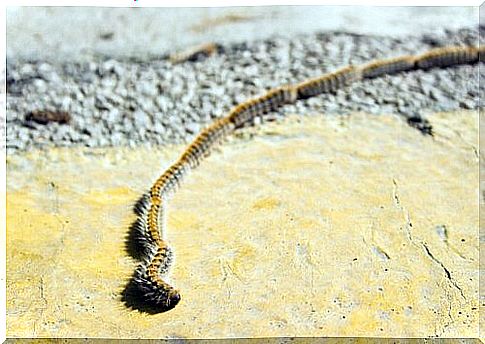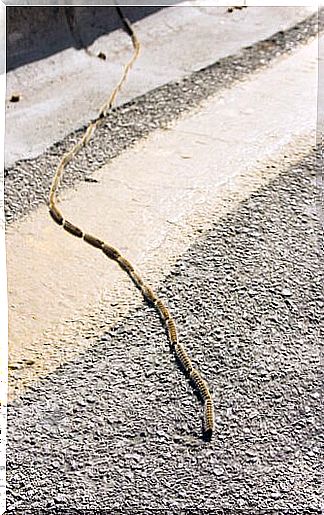What Is The Processionary Caterpillar Like?

When spring arrives and temperatures rise, all kinds of worms and insects begin to appear; among them, the classic processionary caterpillar. This strange animal is mostly seen in the countryside, but it is also starting to appear in parks and gardens in urban areas.
We recognize this species of worm because it forms strange lines that can be very curious. However, the processionary caterpillar, in addition to generating a great environmental impact, poses a serious danger to pets.
Next, we’ll look at some elements to better understand this unique animal and the dangers it brings with it.
Some facts about the processionary caterpillar
The procession caterpillar ( Taumetopoea pitycampa ) is a species of lepidopteran that, every year, invades some areas of the Iberian Peninsula. It is found in the forests of central and southern Europe and is considered a pest.
Caterpillars of this species have black heads and skin and a shade of gray on the sides of the body. They are covered with reddish hairs called trichomes, which can cause a lot of irritation.
That’s why they are dangerous for humans, especially for pets and especially for dogs.
The processionary caterpillar has a social behavior that causes them to line up one after the other. They descend from the nest towards the ground in a single file that they build in the trees, as if it were a procession. Therefore, they are also known as pine processionary caterpillars.

These caterpillars always move together as they form rows; once the moment comes, they burrow into the ground to finish their development there. Then, a few months later, they become butterflies.
They are mainly found in Mediterranean pine, but they are also present in spruce and cedar.
Why is the processionary caterpillar dangerous?
Pine caterpillars are especially dangerous to pets as they can cause allergies and hives.
When they feel threatened, they release their toxic fur, and dogs are the main victims.
Each caterpillar has about 500,000 hairs filled with a toxin called thaumatopoin . These hairs act as real needles capable of injecting this toxin into the skin or mucus of our pets.
They just need to touch one of them or get close to these caterpillars to smell them to be affected. May cause eye, nose, throat irritation or a serious allergic reaction that can be serious.
To control this pest, physical, chemical and biological methods are applied. One of the most common is the burning of nests during the months of September to November.
However, nowadays the pheromone traps for males are widely used. This prevents reproduction and turns out to be a very effective method.

How to know if a dog has been intoxicated
It is very easy for a dog to find one of these caterpillars while walking. And it is more likely that he will approach them, especially if it is a young dog, more restless and curious.
It is possible that your dog will smell, lick, eat or just touch one of these caterpillars with its nose. This will be enough to provoke a reaction.
The signs that a dog has been in contact with a processionary caterpillar and has been intoxicated are varied. The most common are severe itching or hives, swelling of the lips, swelling of the tongue and excessive salivation. The dog will usually also be nervous and agitated, and will try to scratch its mouth with its front paws.
It is possible that the animal also has fever, vomiting or diarrhea if it has swallowed the caterpillar. The most important thing is to be aware of the state of the language.
It usually becomes inflamed and purple. If treatment is not started immediately, areas of necrosis and tissue loss may occur.
Tongue damage can mean your dog will stop eating, with all the problems that will bring.
In more severe cases, facial or pharyngeal edema may occur, causing difficulty in breathing. It is also possible to generate an anaphylactic reaction that can have a fatal outcome.
If you suspect that a dog has been poisoned by a processionary caterpillar, it is recommended to see a specialist immediately. And, as always, the best attitude is to avoid contact with these animals.
It is preferable to avoid walking dogs in areas where there are pine trees during the months of February, March and April to minimize the risk of exposure.









